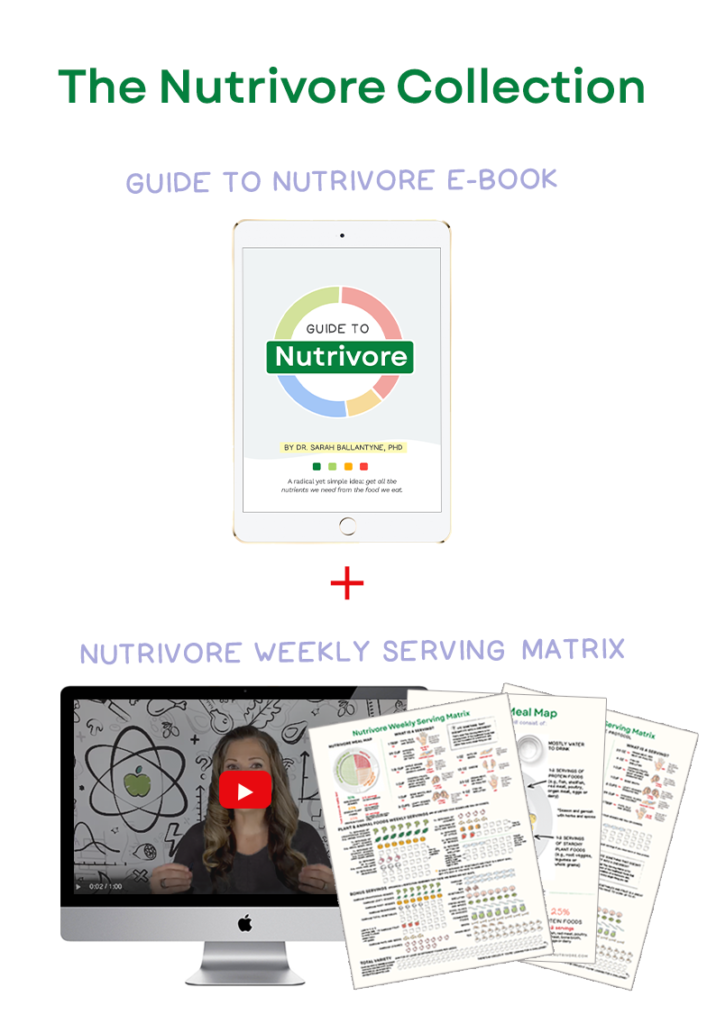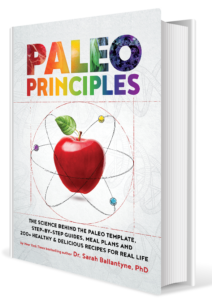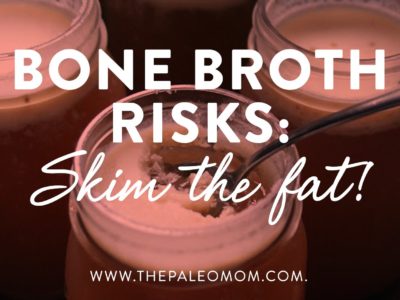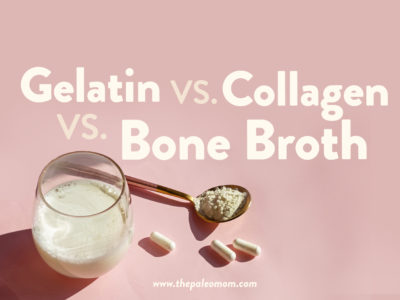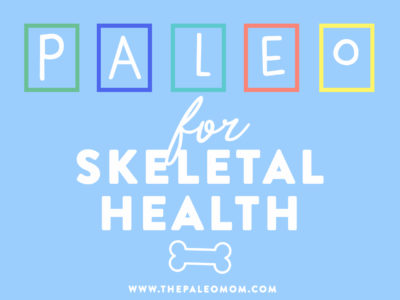 Ginger is perhaps the most famous member of the Zingiberaceae family, which contains about 1600 known species (including turmeric, cardamom, and galangal!). Botanically, ginger is a rhizome, or underground plant stem that continuously grows and sends out lateral shoots and roots. Human use of ginger traces back at least 7,000 years to Southeast Asia, where it was used not only to flavor food, but eventually also used in rituals, to bless ships, to weave baskets (using the plant’s leaves), and as part of traditional systems of medicine. And, it’s enjoyed periods of extremely high value: during the Middle Ages, a pound of ginger was worth the same price as one sheep! Today, ginger does not grow wild any longer but is exclusively a cultivated crop.
Ginger is perhaps the most famous member of the Zingiberaceae family, which contains about 1600 known species (including turmeric, cardamom, and galangal!). Botanically, ginger is a rhizome, or underground plant stem that continuously grows and sends out lateral shoots and roots. Human use of ginger traces back at least 7,000 years to Southeast Asia, where it was used not only to flavor food, but eventually also used in rituals, to bless ships, to weave baskets (using the plant’s leaves), and as part of traditional systems of medicine. And, it’s enjoyed periods of extremely high value: during the Middle Ages, a pound of ginger was worth the same price as one sheep! Today, ginger does not grow wild any longer but is exclusively a cultivated crop.
Table of Contents[Hide][Show]
Nutrients in Ginger
Ginger is extremely nutrient dense, although we rarely eat it in large enough quantities to obtain significant macronutrients or micronutrients. Five slices of raw ginger root contain 9 calories and small amounts of manganese, copper, potassium, magnesium, vitamin B6, and vitamin C, and fiber.
 Where ginger really shines is in its phytonutrient content! In particular, it’s rich in phenolic compounds such as gingerols, zingerone, shogaols, quercetin, paradols, and gingerenone A, as well as terpenes such as zingiberene, β-bisabolene, α-curcumene, α-farnesene, and β-sesquiphellandrene. See also The Amazing World of Plant Phytochemicals: Why a diet rich in veggies is so important! and Polyphenols: Magic Bullet or Health Hype?
Where ginger really shines is in its phytonutrient content! In particular, it’s rich in phenolic compounds such as gingerols, zingerone, shogaols, quercetin, paradols, and gingerenone A, as well as terpenes such as zingiberene, β-bisabolene, α-curcumene, α-farnesene, and β-sesquiphellandrene. See also The Amazing World of Plant Phytochemicals: Why a diet rich in veggies is so important! and Polyphenols: Magic Bullet or Health Hype?
Thanks to its high concentration of these compounds, ginger offers some pronounced health benefits even when eaten in small quantities. For example, ginger’s reputation as a stomach-soother has been verified by research; it can protect against nausea in a variety of situations, including morning sickness and nausea following surgery or associated with chemotherapy. But, it doesn’t end there: ginger has also been found to have anti-inflammatory, anti-cancer, neuroprotective, cardioprotective, anti-obesity, anti-diabetic, lung-protective, anti-pain, and antimicrobial properties across a wide body of scientific research!
Health Benefits of Ginger
A number of studies have found that ginger and its bioactive compounds (especially 6-shogaol, 6-dehydroshogaol, and zingerone) affect phosphatidylinositol-3-kinase, protein kinase B, and NF-kB, explaining some of its anti-inflammatory properties and its protective role against inflammation-related diseases.
 Research has also demonstrated a protective role for ginger against some types of cancer (including breast cancer, cervical cancer, prostate cancer, gastric cancer, and colorectal cancer), through inhibiting cancer cell proliferation and inducing apoptosis (programmed cell death). In patients at a high risk of colorectal cancer, supplementing with 2 grams of ginger per day significantly decreased the expression of COX-1—a key enzyme for producing prostaglandin E2, which plays a major role in promoting colon cancer growth. Likewise, the ginger phytonutrients 6-gingerol, 6-shogaol, 10-gingerol, and 10-shogaol have been shown to reduce the growth of human prostate cancer cells, by downregulating protein expression of glutathione-S-transferase and MRP1. In cervical cancer cells, 6-gingerol was able to inhibit growth by decreasing protein levels of cyclin A and cyclin D1, inducing cell cycle arrest. And, in a mouse model of breast cancer, ginger extract activated AMPK, downregulated cyclin D1, and promoted apoptosis by increasing tumor suppressor gene p53 and decreasing NF-kB levels in tumor tissue, leading to significant protection against breast cancer growth.
Research has also demonstrated a protective role for ginger against some types of cancer (including breast cancer, cervical cancer, prostate cancer, gastric cancer, and colorectal cancer), through inhibiting cancer cell proliferation and inducing apoptosis (programmed cell death). In patients at a high risk of colorectal cancer, supplementing with 2 grams of ginger per day significantly decreased the expression of COX-1—a key enzyme for producing prostaglandin E2, which plays a major role in promoting colon cancer growth. Likewise, the ginger phytonutrients 6-gingerol, 6-shogaol, 10-gingerol, and 10-shogaol have been shown to reduce the growth of human prostate cancer cells, by downregulating protein expression of glutathione-S-transferase and MRP1. In cervical cancer cells, 6-gingerol was able to inhibit growth by decreasing protein levels of cyclin A and cyclin D1, inducing cell cycle arrest. And, in a mouse model of breast cancer, ginger extract activated AMPK, downregulated cyclin D1, and promoted apoptosis by increasing tumor suppressor gene p53 and decreasing NF-kB levels in tumor tissue, leading to significant protection against breast cancer growth.
Excitingly, ginger (and specifically its phytonutrients 10-gingerol, 6-shogaol, and 6-dehydrogingerdione) also have neuroprotective benefits! Some studies suggest that ginger has a positive effect on memory and can reduce neuroinflammation, potentially giving it a role in combatting neurodegenerative diseases. In particular, 10-gingerol has been identified as the compound responsible for fresh ginger’s anti-neuroinflammatory properties, and has been shown to block NF-kB activation, reduce levels of nitric oxide, IL-1β, IL-6, and TNF-α, leading to lower expression of proinflammatory genes. In rodent models of impaired memory, ginger extract was able to improve cognitive function (as shown by novel object recognition tests), and appeared to promote the formation of synapses within the brain by activating extracellular signal-regulated kinase (ERK). Similarly, 6-shogaeol demonstrated neuroprotective activity through scavenging free radicals, activating Nrf2, and increasing levels of phase II antioxidant molecules like HO-1 and NQO1. An experiment using a mouse model of Alzheimer’s disease also found that fermented ginger reduced memory impairment by protecting neuronal cells in the hippocampus, while also increasing levels of presynaptic and postsynaptic proteins. Although more studies in humans are needed, the mechanistic and animal studies we have so far are promising!
Ginger also appears to be very healthy for the heart. In vitro, a variety of ginger extracts (methanolic, ethanolic, hexane, ethyl acetate, and water) have been shown to inhibit up to 76% of LDL oxidation from copper, suggesting a mechanism for protecting against heart disease. In rats fed a high-fat diet, for example, ginger extract raised HDL levels and lowered triglycerides, while also reducing very low-density lipoprotein levels, leading to a blood lipid profile associated with better cardiovascular health. In rats with hypertension, ginger consumption also significantly lowered their blood pressure, apparently due to decreasing the activities of angiotensin-1 converting enzyme and arginase. And, a cross-sectional observational study of humans found that daily ginger consumption was associated with a 13% lower risk of heart disease and 8% lower risk of hypertension. See also The Paleo Diet for Cardiovascular Disease
Ginger may even play a beneficial role in weight control. In mice fed high-fat diets, the phytonutrient gingerone A has was able to modulate fatty acid metabolism by activating AMPK, leading to protection against diet-induced obesity. In vitro, 6-shogaol and 6-gingerol have also been shown to enhance cellular fat catabolism by increasing peroxisome proliferator-activated receptor δ (PPARδ)-dependent gene expression. And in a randomized, double-blind, placebo-controlled trial of obese women, consuming 2 grams of ginger powder each day led to reduced BMI (as well as serum insulin and HOMA-IR index) over the course of 12 weeks. See also Paleo for Weight Loss
 In addition, ginger shows promise for helping protect against diabetes. In mice with diet-induced obesity, 6-gingerol was able to reduce insulin and plasma glucose levels, while decreasing Nε-carboxymethyl-lysine (a marker of AGEs) through Nrf2 activation. In a different experiment of high-fat fed mice, the ginger phytonutrient 6-paradol significantly lowered blood glucose levels. Diabetic mice also responded to 6-gingerol treatment with increased cell membrane presentation of GLUT4, leading to greater glycogen storage in skeletal muscle tissue. And ginger’s anti-diabetic effects aren’t limited to animals: in a double-blinded, placebo-controlled trial of humans with type 2 diabetes, 1600 mg of ginger daily for 12 weeks lead to significantly lower fasting blood sugar, insulin, HOMA, triglycerides, HbA1C, total cholesterol, CRP, and PGE2 compared with the placebo group. A similar study found that 2 grams of ginger daily for two months, supplemented to patients with type 2 diabetes, led to significantly lower insulin, triglycerides, and HOMA index, while increasing the quantitative insulin sensitivity check index. See also The Paleo Diet for Diabetes, 3 Ways to Regulate Insulin that Have Nothing to Do With Food, and The Case for More Carbs: Insulin’s NonMetabolic Roles in the Human Body.
In addition, ginger shows promise for helping protect against diabetes. In mice with diet-induced obesity, 6-gingerol was able to reduce insulin and plasma glucose levels, while decreasing Nε-carboxymethyl-lysine (a marker of AGEs) through Nrf2 activation. In a different experiment of high-fat fed mice, the ginger phytonutrient 6-paradol significantly lowered blood glucose levels. Diabetic mice also responded to 6-gingerol treatment with increased cell membrane presentation of GLUT4, leading to greater glycogen storage in skeletal muscle tissue. And ginger’s anti-diabetic effects aren’t limited to animals: in a double-blinded, placebo-controlled trial of humans with type 2 diabetes, 1600 mg of ginger daily for 12 weeks lead to significantly lower fasting blood sugar, insulin, HOMA, triglycerides, HbA1C, total cholesterol, CRP, and PGE2 compared with the placebo group. A similar study found that 2 grams of ginger daily for two months, supplemented to patients with type 2 diabetes, led to significantly lower insulin, triglycerides, and HOMA index, while increasing the quantitative insulin sensitivity check index. See also The Paleo Diet for Diabetes, 3 Ways to Regulate Insulin that Have Nothing to Do With Food, and The Case for More Carbs: Insulin’s NonMetabolic Roles in the Human Body.
Although less commonly known, ginger may also help alleviate some respiratory disorders. Ginger is able to induce fast and significant relaxation in the airway smooth muscle while reducing airway resistance and inflammation, with a variety of human and animal studies showing that 6-gingerol, 6-shogaol, and 8-gingerol in particular are responsible for these effects! See also Paleo for Asthma and Allergies
And perhaps most famously, ginger has an impressive scientific track record for treating nausea and pain! Ginger has been shown to help reduce nausea and vomiting associated with surgery, elective C-sections, chemotherapy, motion sickness, and pregnancy, due in part to suppressing the activation of serotonin receptors in enteric neurons (and reducing sensations of nausea as a result). A systematic review and meta-analysis of 12 randomized controlled trials, encompassing a total of 1,278 pregnant women, found that eating about 1.5 grams of ginger is able to significantly reduce symptoms of morning sickness. Daily ginger consumption has been shown to reduce muscle pain, and may also help alleviate menstrual pain. In fact, one study of dysmenorrheic women showed that taking four daily doses of ginger powder (250 mg) during the first three days of menstruation was able to reduce menstrual pain as much as two different NSAIDs! Another study found that eating 2 grams of either raw or heated ginger for 11 consecutive days led to significant reductions in muscle pain following exercise-induced injury.
Nutrivore Weekly Serving Matrix
An easy-to-use and flexible weekly checklist
to help you maximize nutrient-density.
The Weekly Serving Matrix is very helpful! I’ve been eating along these lines but this really helps me know where to focus vs. which foods serve a more secondary role. It’s super helpful and has taken a lot of worry out of my meal planning. Thanks!
Jan
Ginger Is Also Great for the Gut!
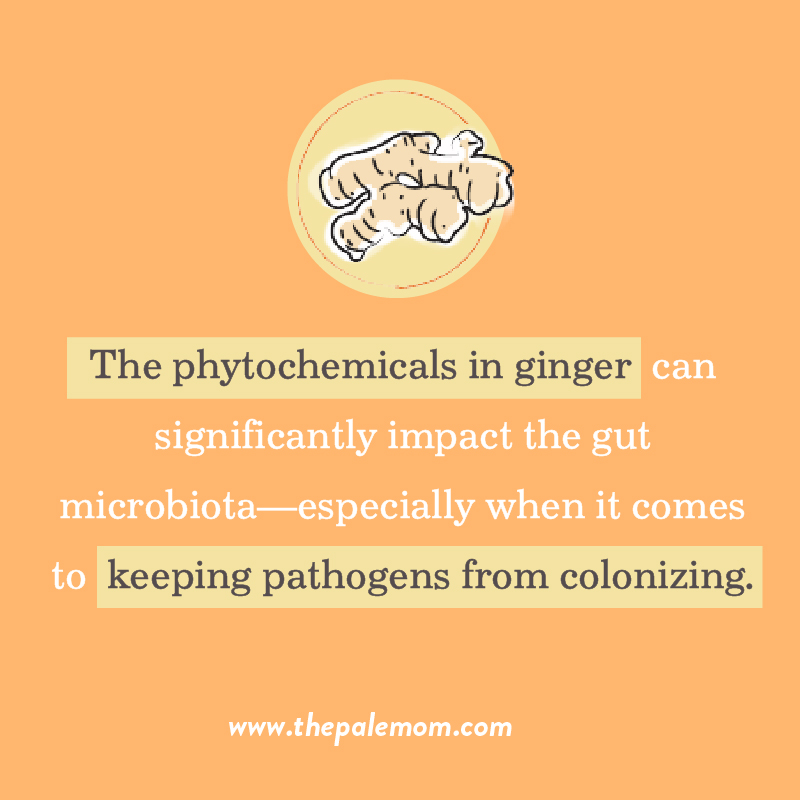 As far as the gut is concerned, ginger is also a win! The phytochemicals in ginger can significantly impact the gut microbiota—especially when it comes to keeping pathogens from colonizing. See also What Is the Gut Microbiome? And Why Should We Care About It?. The anti-microbial properties of ginger appear to work through inhibiting biofilm formation, reducing viral attachment to host cells, and preventing ergosterol biosynthesis (a key sterol in fungal cell membranes). One study found that ginger inhibited a drug-resistant strain of the pathogen Pseudomonas aeruginosa from growing, through inhibiting biofilm formation and affecting membrane integrity; another study found that the ginger components gingerenone-A and 6-shogaol reduced Staphylococcus aureus growth by inhibiting one of the pathogen’s enzymes (6-hydroxymethyl-7, 8-dihydropterin pyrophosphokinase). What’s more, essential oils in ginger can cause a loss of membrane integrity in fungi, in turn reducing its growth. This has been demonstrated in the fungal species Fusarium verticilliodes and Aspergillus flavus (the fungus that produces the carcinogen aflatoxin).
As far as the gut is concerned, ginger is also a win! The phytochemicals in ginger can significantly impact the gut microbiota—especially when it comes to keeping pathogens from colonizing. See also What Is the Gut Microbiome? And Why Should We Care About It?. The anti-microbial properties of ginger appear to work through inhibiting biofilm formation, reducing viral attachment to host cells, and preventing ergosterol biosynthesis (a key sterol in fungal cell membranes). One study found that ginger inhibited a drug-resistant strain of the pathogen Pseudomonas aeruginosa from growing, through inhibiting biofilm formation and affecting membrane integrity; another study found that the ginger components gingerenone-A and 6-shogaol reduced Staphylococcus aureus growth by inhibiting one of the pathogen’s enzymes (6-hydroxymethyl-7, 8-dihydropterin pyrophosphokinase). What’s more, essential oils in ginger can cause a loss of membrane integrity in fungi, in turn reducing its growth. This has been demonstrated in the fungal species Fusarium verticilliodes and Aspergillus flavus (the fungus that produces the carcinogen aflatoxin).
In one study, commercial ginger root paste and fresh ginger root paste were heated with ground beef, inoculated with E. coli 157:H7, and then left in storage at 4 degrees C or 8 degrees C for two weeks. The commercial ginger paste completely inactivated the E. coli at the three-day mark for both storage temperatures, while the fresh ginger paste showed antimicrobial activity only when stored at 8 degrees C. (Turmeric paste was tested as well, but didn’t show any antimicrobial activity against E. coli). Another in vitro study found that digested ginger extract was able to modulate the fecal microbiota, including promoting the growth of beneficial Bifidobacterium and Enterococcus, raising levels of short-chain fatty acids, and decreasing the pH of the simulated intestinal environment. This study found that 6-gingerol, the main polyphenol in ginger extract, was the main driver behind raising levels of beneficial bacteria. And in mice, ginger appears to have anti-obesity effects that are mediated through the microbiota—more specifically, enhancing levels of Bifidobacteria and SCFA-producing members of Alloprevotella and Allobaculum.
Hoorah for Ginger!
All in all, ginger is a flavorful rhizome with some great benefits to offer us! In addition to the recipes in The Gut Health Cookbook (like Fresh Ginger Coffee Cake, yum!), check out these gingery recipe:
- Ginger-Garlic Cauliflower Rice
- Gingerbread Cut-Outs (Revisited)
- Honey-Candied Ginger
- Ginger Chocolate Freezer Fudge
- Ginger-Lemon Jasmine Kombucha
- Pumpkin Gingerbread Muffins (Nut-Free)
- Halloween AIP Monster Finger Cookies
Citations
Akinyemi AJ, et al. “Dietary supplementation of ginger and turmeric improves reproductive function in hypertensive male rats.” Toxicol Rep. 2015 Oct 13;2:1357-1366. doi: 10.1016/j.toxrep.2015.10.001. eCollection 2015.
Arablou T, et al. “The effect of ginger consumption on glycemic status, lipid profile and some inflammatory markers in patients with type 2 diabetes mellitus.” Int J Food Sci Nutr. 2014 Jun;65(4):515-20. doi: 10.3109/09637486.2014.880671. Epub 2014 Feb 4.
Attari VE, et al. “Changes of serum adipocytokines and body weight following Zingiber officinale supplementation in obese women: a RCT.” Eur J Nutr. 2016 Sep;55(6):2129-36. doi: 10.1007/s00394-015-1027-6. Epub 2015 Aug 29.
Black CD, et al. “Ginger (Zingiber officinale) reduces muscle pain caused by eccentric exercise.” Pain. 2010 Sep;11(9):894-903. doi: 10.1016/j.jpain.2009.12.013. Epub 2010 Apr 24.
Chakotiya AS, et al. “Zingiber officinale: Its antibacterial activity on Pseudomonas aeruginosa and mode of action evaluated by flow cytometry.” Microb Pathog. 2017 Jun;107:254-260. doi: 10.1016/j.micpath.2017.03.029. Epub 2017 Apr 4.
Ernst E & Pittler MH. “Efficacy of ginger for nausea and vomiting: a systematic review of randomized clinical trials.” Br J Anaesth. 2000 Mar;84(3):367-71. doi: 10.1093/oxfordjournals.bja.a013442.
Gupta S & Ravishankar S. “A comparison of the antimicrobial activity of garlic, ginger, carrot, and turmeric pastes against Escherichia coli O157:H7 in laboratory buffer and ground beef.” Foodborne Pathog Dis. Winter 2005;2(4):330-40. doi: 10.1089/fpd.2005.2.330.
Ho S-C, et al. “Anti-neuroinflammatory capacity of fresh ginger is attributed mainly to 10-gingerol.” Food Chem. 2013 Dec 1;141(3):3183-91. doi: 10.1016/j.foodchem.2013.06.010. Epub 2013 Jun 11.
Jiang Y, et al. “Effect of ginger root on cyclooxygenase-1 and 15-hydroxyprostaglandin dehydrogenase expression in colonic mucosa of humans at normal and increased risk for colorectal cancer.” Eur J Cancer Prev. 2013 Sep;22(5):455-60. doi: 10.1097/CEJ.0b013e32835c829b.
Khandouzi N, et al. “The effects of ginger on fasting blood sugar, hemoglobin a1c, apolipoprotein B, apolipoprotein a-I and malondialdehyde in type 2 diabetic patients.” Iran J Pharm Res. Winter 2015;14(1):131-40.
Mahluji S, et al. “Effects of ginger (Zingiber officinale) on plasma glucose level, HbA1c and insulin sensitivity in type 2 diabetic patients.” Int J Food Sci Nutr. 2013 Sep;64(6):682-6. doi: 10.3109/09637486.2013.775223. Epub 2013 Mar 18.
Mao Q-Q, et al. “Bioactive Compounds and Bioactivities of Ginger (Zingiber officinale Roscoe).” Foods. 2019 May 30;8(6):185. doi: 10.3390/foods8060185.
Ozgoli G, et al. “Comparison of effects of ginger, mefenamic acid, and ibuprofen on pain in women with primary dysmenorrhea.” J Altern Complement Med. 2009 Feb;15(2):129-32. doi: 10.1089/acm.2008.0311.
Sampath C, et al. “Specific bioactive compounds in ginger and apple alleviate hyperglycemia in mice with high fat diet-induced obesity via Nrf2 mediated pathway.” Food Chem. 2017 Jul 1;226:79-88. doi: 10.1016/j.foodchem.2017.01.056. Epub 2017 Jan 16.
Suk Sujin, et al. “Gingerenone A, a polyphenol present in ginger, suppresses obesity and adipose tissue inflammation in high-fat diet-fed mice.” Mol Nutr Food Res. 2017 Oct;61(10):10.1002/mnfr.201700139. doi: 10.1002/mnfr.201700139. Epub 2017 Jul 20.
Viljoen E, et al. “A systematic review and meta-analysis of the effect and safety of ginger in the treatment of pregnancy-associated nausea and vomiting.” Nutr J. 2014 Mar 19;13:20. doi: 10.1186/1475-2891-13-20.
Wang J, et al. “Assessing the Effects of Ginger Extract on Polyphenol Profiles and the Subsequent Impact on the Fecal Microbiota by Simulating Digestion and Fermentation In Vitro.” Nutrients. 2020 Oct 19;12(10):3194. doi: 10.3390/nu12103194.
Wang Y, et al. “Evaluation of daily ginger consumption for the prevention of chronic diseases in adults: A cross-sectional study.” Nutrition. 2017 Apr;36:79-84. doi: 10.1016/j.nut.2016.05.009. Epub 2016 Jun 3.
Zhang F, et al. “Assessment of anti-cancerous potential of 6-gingerol (Tongling White Ginger) and its synergy with drugs on human cervical adenocarcinoma cells.” Food Chem Toxicol. 2017 Nov;109(Pt 2):910-922. doi: 10.1016/j.fct.2017.02.038. Epub 2017 Feb 27.



